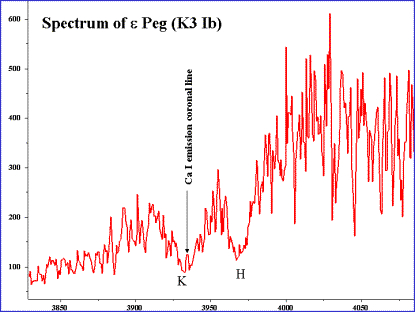NORMAL STARS SPECTRA
Spectral classes:
- O
- B
- A
- F
- G
- K
- M
Type K stars
In K spectral class there is a big difference in luminosity between giants and dwarfs.
Dwarfs are smaller and colder than our sun (temperature ranges from 4700 to 3000 K) and
for this reason there are few dwarfs that can be seen with the naked eye.
The brighter K dwarf for the northern emisphere is 61 Cyg B that shines at 5,6 mag
because of its shord distance (11 ly).
Together with its fainter companion, the total magnitude is 4,8. Both 61 Cyg A and B
belong to K spectral class. The brighter is K5 and the fainter K7.
Among the brightest K type stars we find:
Among the dwarfs: 54 Psc (K0 V), 107 Psc (K1 V), a Cen B (K1 V), 40 Eri A (K2 V), 61 Cyg A (K5 V)
Among the giants: b
Gem (K0 III), a Uma (K0 III), Arcturus
(K2 pec),á y Uma (K2 III), d And
(K3 III), Aldebaran (K5 III)
Among the supergiants:
e Peg (K3 I)

|
|
Picture 1: Spectrum of Aldebaran (a Tau, K5 III)
recorded with resolution better than 1 ┼. Click on the image for full resolution spectrum
with line identification.
|
Compared to M class stars, in the spectrum of K stars we can still see (although weak)
the hydrogen Balmer lines and the Ca II H and K broad absorbtions.
Compared to warmer G stars, we can see a general decrease of the intensity of the ionized
elements lines (like, for example Ba II, Sr II, Fe II) while the spectrum is filled of
neutral metals lines.
Type K stars, as well as G and M stars, are surrounded by a chromosphere. We can observe
the Ca II emission lines due to the chromosphere at the center of the broad photospheric
H and K absorption.
For observations of coronal lines the K line is preferred because H line is confused with
one of the Balmer hydrogen lines.
At the center of the coronal emission line (called K2), a second absorbption (called K 3)
can be observed due to the chromospheric self absorbtion.
In 1956 Wilson and Bappu discovered that the width of K2 increase with the brightess of the star.
Thus the measure of K2 allows a quantitative determination of the luminosity class.
Unfortunately the spectral resolution necessary to measure the width of K2 is much
higher than our own spectrograph's.
For the moment we are just able to see the coronal line (picture 2). Nevertheless it is
not bad to record an evidence of chromospheric activity of a star other than our sun.

|
|
Picture 2: Spectrum of Enif ( e Peg - K3 Ib)
that shows the coronal line K2 inside the broad Ca II photospheric absorbtion.
Our 0,7 ┼ spectral resolution is not enough to show the self reversed absorbtion K3, nor the
broadening of K2.
The spectrum was recorded on 12th dec 2001 with a 1800 l/mm grating and a focusing f=50mm optics.
|
Vai agli altri tipi spettrali:
O
- B
- A
- F
- G
- M
|
|


